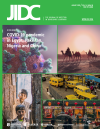Antibiotic prescribing and the risk of antibiotic–associated diarrhoea in Korle Bu Teaching Hospital, Ghana: a pilot study
DOI:
https://doi.org/10.3855/jidc.11259Keywords:
Antibiotic, diarrhea, antibiotic-associated diarrhea, antibiotic-associated diarrhea prevalence, GhanaAbstract
Introduction: This study sought to identify the association of antibiotic prescribing and the risk of antibiotic-associated diarrhoea (AAD) in Korle Bu Teaching Hospital (KBTH) in Ghana.
Methodology: Patients from the Male Urology Ward and Treatment Room of the Surgical Department of KBTH were followed up over three months to determine if they had experienced any unusual diarrhoeal illness after antibiotic therapy. 81 eligible patients (adults) were included in the study but a total of 70 patients (mean age of 56.71 years) were successfully followed up during the study period.
Results: The top conditions presented by patients were urological infection (66.7%), cancer (15.3%) and leg ulcer (18.1%). Ciprofloxacin (50%) and ceftriaxone (28.5%) were the most prescribed antibiotics. Eleven patients (more than 1 in 7) developed diarrhoea that could be associated with their use of antibiotics. The occurrence of AAD was significantly associated with type of antibiotic used by patient. 73% of patients who developed symptoms of AAD had received Clindamycin. Risk of AAD was not significantly associated with age and comorbidities.
Conclusions: The rate of AAD in the Male Urology Ward and the Treatment Room of the Surgical Department of KBTH during the period of this study was 15.7%. Clindamycin was identified as the most implicated antibiotic.
Downloads
Published
How to Cite
Issue
Section
License
Authors who publish with this journal agree to the following terms:
- Authors retain copyright and grant the journal right of first publication with the work simultaneously licensed under a Creative Commons Attribution License that allows others to share the work with an acknowledgement of the work's authorship and initial publication in this journal.
- Authors are able to enter into separate, additional contractual arrangements for the non-exclusive distribution of the journal's published version of the work (e.g., post it to an institutional repository or publish it in a book), with an acknowledgement of its initial publication in this journal.
- Authors are permitted and encouraged to post their work online (e.g., in institutional repositories or on their website) prior to and during the submission process, as it can lead to productive exchanges, as well as earlier and greater citation of published work (See The Effect of Open Access).








